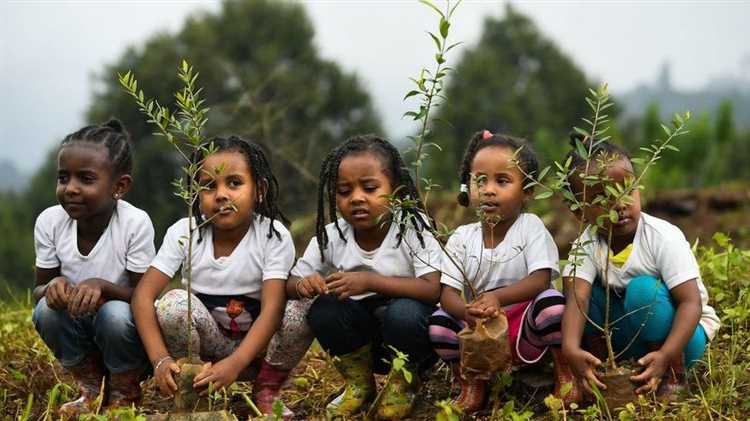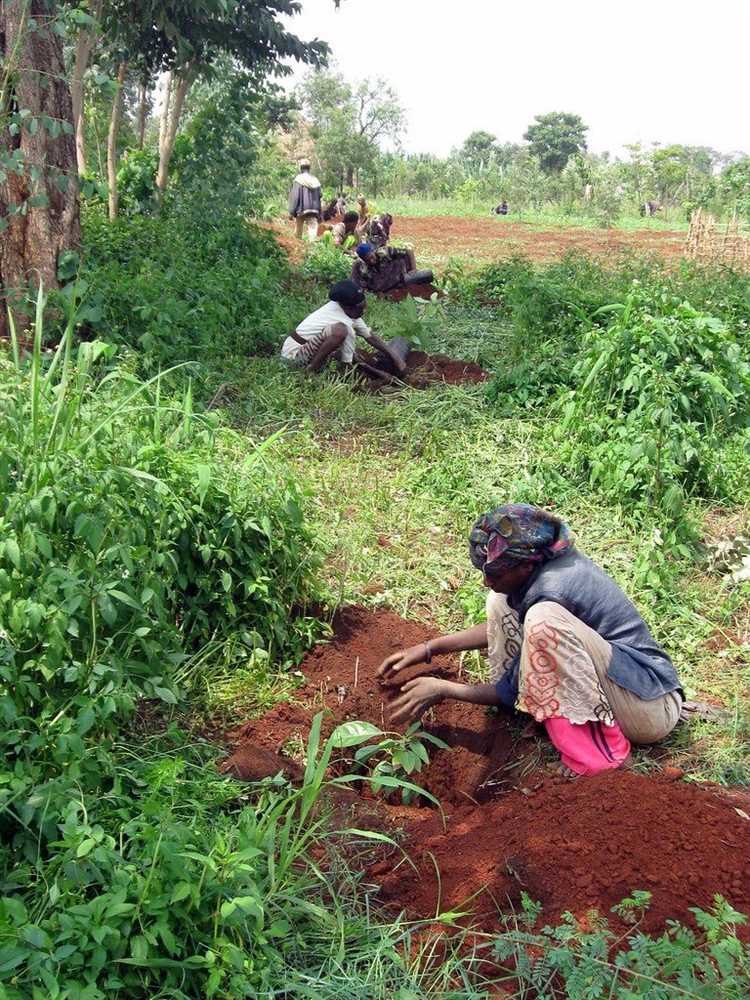
In recent years, there has been an increasing global concern about deforestation and its negative impact on the environment. Many countries have recognized the urgency of reforestation efforts and have taken initiatives to plant more trees. However, one country stands out for its exceptional achievement in this regard.
The title for planting the most trees in one day goes to India, a country known for its rich biodiversity and commitment to environmental conservation. In July 2016, more than 800,000 volunteers joined forces to plant a staggering 50 million trees in just 24 hours. This record-breaking mass tree planting event, organized by the Uttar Pradesh government, aimed to combat deforestation and create a greener future.
India’s impressive feat not only symbolizes the country’s determination to combat climate change but also highlights the power of collective action. The initiative not only involved government agencies and non-profit organizations but also engaged local communities and individuals, emphasizing the importance of individual contributions in achieving large-scale environmental goals.
In addition to mitigating climate change, the mass tree planting event in India had numerous other benefits. The new forests created from this initiative would serve as habitats for wildlife, provide a source of livelihood for local communities, and contribute to water conservation efforts. The magnitude of this achievement has inspired other countries to replicate India’s success and take similar action to combat deforestation.
- Overview and Importance of Reforestation
- The Guinness World Record Holder
- Environmental Impact of Mass Tree Planting
- The Importance of Sustainable Tree Planting Practices
- The Role of Community Engagement
- Challenges Faced by the Record-Setting Country
- Lessons and Inspirations for Other Nations
- Question and answer:
- Which country holds the record for planting the most trees in one day?
- How many trees did Pakistan plant in one day?
- Why did Pakistan attempt to plant so many trees in one day?
- Is this the first time Pakistan has attempted to break the record for tree planting?
- What measures did Pakistan take to ensure the success of the tree planting campaign?
- Which country holds the record for planting the most trees in one day?
- Why did India organize a tree-planting campaign?
Overview and Importance of Reforestation
Reforestation is the process of planting trees in areas where they have been cut down or destroyed. It plays a crucial role in restoring and maintaining the health of our planet’s ecosystems. The need for reforestation has increased in recent years due to deforestation, urbanization, and climate change.
One of the main reasons why reforestation is important is its ability to combat climate change. Trees absorb carbon dioxide, a greenhouse gas that contributes to global warming, through the process of photosynthesis. By planting more trees, we can help reduce the amount of carbon dioxide in the atmosphere and slow down the pace of climate change.
Additionally, reforestation helps to prevent soil erosion and improve water quality. Trees act as natural barriers, preventing soil from being washed away by rain and reducing the risk of landslides. Their roots also help to filter out pollutants and sediments, ensuring that water sources remain clean and healthy.
Reforestation is also beneficial for biodiversity conservation. Trees provide habitats for numerous plant and animal species, promoting biodiversity and preserving ecosystems. They offer food, shelter, and nesting sites for a variety of organisms, contributing to the overall balance and stability of ecosystems.
Moreover, reforestation has social and economic benefits. Forests are a source of livelihood for many communities, providing them with resources such as timber, firewood, and non-timber forest products. Reforestation projects can create employment opportunities and stimulate local economies.
Overall, reforestation is a vital tool in the fight against climate change, the preservation of biodiversity, and the improvement of global environmental health. It serves as a long-term solution to the negative impacts of deforestation and offers numerous benefits for both the natural world and human society.
The Guinness World Record Holder

In the world of environmental conservation and tree planting, one country stands out as the Guinness World Record holder for the most trees planted in a single day. That country is India.
On July 11, 2016, India broke the previous record by planting a staggering 50 million trees in just 24 hours. This remarkable feat was achieved through the combined efforts of over 800,000 volunteers across the country.
The initiative, known as the “Green India Mission”, was launched by the Indian government as a response to the growing environmental concerns in the country. The goal of the mission is to increase India’s forest cover and combat climate change through massive tree planting efforts.
Not only did India plant a record-breaking number of trees, but they also showcased their commitment to sustainability and environmental awareness. The event captured global attention and highlighted India’s determination to tackle environmental challenges head-on.
The Guinness World Record achievement was not just about breaking a record. It was a symbol of hope and inspiration for other countries and organizations to follow suit. India’s success in tree planting serves as an important reminder of the power of collective action and highlights the role of individuals in making a positive impact on the environment.
Since breaking the record, India has continued to prioritize afforestation efforts and has set ambitious targets for increasing its forest cover. The country’s commitment to environmental conservation serves as a shining example for the rest of the world.
India’s achievement as the Guinness World Record holder for tree planting is a testament to the country’s dedication to preserving its natural resources and creating a sustainable future for generations to come. It serves as a reminder that small actions can make a big difference in the fight against climate change.
India’s Guinness World Record for tree planting stands as a beacon of hope, inspiring others to join the cause and work towards a greener and more sustainable planet.
Environmental Impact of Mass Tree Planting
Mass tree planting initiatives have the potential to create significant positive environmental impacts. By planting a large number of trees, we can help combat deforestation, restore wildlife habitats, and mitigate climate change.
One of the main benefits of mass tree planting is the ability to combat deforestation. Trees play a crucial role in absorbing carbon dioxide and releasing oxygen back into the atmosphere through photosynthesis. By planting more trees, we can help reduce the amount of carbon dioxide in the atmosphere and decrease the effects of deforestation.
In addition to combating deforestation, mass tree planting initiatives also have a positive impact on wildlife habitats. Trees provide shelter, food, and nesting sites for various species of animals and birds. By increasing tree cover, we can create new habitats and support the biodiversity of ecosystems.
Furthermore, mass tree planting helps to mitigate climate change. Trees act as a natural carbon sink, absorbing carbon dioxide from the atmosphere and storing it in their trunks, branches, and roots. By planting trees in large numbers, we can help remove significant amounts of carbon dioxide from the atmosphere and reduce the greenhouse effect.
The Importance of Sustainable Tree Planting Practices

While mass tree planting can have a positive environmental impact, it is essential to emphasize the importance of sustainable planting practices. Care must be taken to ensure that the trees are planted in appropriate locations and that they are the right species for the area.
Sustainable tree planting practices also involve regular maintenance and care for the planted trees to ensure their long-term survival and growth. This includes watering, pruning, and protection from pests and diseases.
The Role of Community Engagement
Mass tree planting initiatives are more likely to succeed when there is strong community engagement. Involving local communities in the planting process fosters a sense of ownership and responsibility, leading to a higher rate of tree survival and long-term maintenance.
Community engagement also helps raise awareness about the importance of trees and their environmental benefits. It can encourage individuals and organizations to participate in future tree planting initiatives and take actions to protect and preserve existing forests.
In conclusion, mass tree planting has a significant environmental impact, including combating deforestation, restoring wildlife habitats, and mitigating climate change. However, it is crucial to practice sustainable planting techniques and involve local communities to ensure the long-term success of these initiatives.
Challenges Faced by the Record-Setting Country
The record-setting country that planted the most trees in one day faced several challenges during their endeavor. Despite their impressive accomplishment, they had to overcome various obstacles to achieve their goal.
One of the main challenges was sourcing an adequate number of tree seedlings. Planting a large number of trees requires a significant supply of young plants. The country had to ensure they had enough seedlings available and ready for planting on the designated day. This involved coordinating with nurseries and tree farms to ensure a sufficient quantity of healthy and diverse tree species.
Another challenge was finding suitable planting locations. It was crucial for the country to identify areas where planting would have the most impact in terms of ecological restoration and carbon sequestration. Identifying suitable lands and securing permits to plant trees on them required extensive research and collaboration with landowners and government agencies.
The logistical aspect of organizing such a massive tree-planting event was also a significant challenge. Coordinating the efforts of thousands of volunteers, providing them with the necessary tools and equipment, and ensuring everyone had clear instructions and guidance required meticulous planning and execution. A massive undertaking like this required efficient organization and communication to ensure smooth operations on the planting day.
Furthermore, the country faced challenges related to post-planting care and maintenance. Simply planting trees is not enough; ensuring their survival and growth is equally important. The country had to develop strategies to monitor and nurture the newly planted trees, including watering, protection from pests and diseases, and regular maintenance activities. This required the involvement of local communities and the allocation of resources for long-term tree care.
Overall, the record-setting country had to overcome various challenges to successfully plant the most trees in one day. Their dedication, planning, and coordination were key factors in overcoming these obstacles and achieving their remarkable feat.
Lessons and Inspirations for Other Nations

The incredible achievement of planting the most trees in one day by [Country Name] serves as an inspiration and provides valuable lessons for other nations around the world. Here are some key takeaways:
| 1. Strong Government Initiatives |
One of the main factors contributing to the success of [Country Name] was the strong government initiatives in promoting and supporting large-scale reforestation projects. The government played a crucial role in coordinating efforts, providing necessary resources, and creating an enabling environment for community participation. |
| 2. Community Engagement and Participation |
Another important lesson is the power of community engagement and participation. [Country Name] successfully involved local communities, schools, and organizations in the tree-planting campaign. This not only resulted in a higher number of trees planted but also created a sense of ownership and responsibility among the locals towards their environment. |
| 3. Collaboration and Partnerships |
Collaboration and partnerships with various stakeholders such as NGOs, businesses, and international organizations were instrumental in the success of [Country Name]’s tree-planting campaign. These collaborations allowed for the pooling of resources, expertise, and knowledge, leading to a more impactful and sustainable reforestation effort. |
| 4. Long-term Planning and Commitment |
The achievement of [Country Name] highlights the importance of long-term planning and commitment. Planting a large number of trees in a single day is impressive, but sustaining and maintaining these trees in the long run requires ongoing efforts, resources, and dedication. It is crucial for other nations to develop comprehensive and sustainable strategies that go beyond mere symbolic gestures. |
| 5. Education and Awareness |
Education and awareness are essential components for successful reforestation campaigns. [Country Name] prioritized educating its citizens and raising awareness about the importance of trees, the benefits of reforestation, and the role individuals can play in the process. This approach had a positive impact on public perception and contributed to the overall success of the campaign. |
By learning from the experiences of [Country Name], other nations can devise effective strategies and programs to address deforestation and contribute to the preservation of the environment for future generations. The remarkable achievement of planting the most trees in one day serves as a reminder of the power and responsibility each nation holds in combating climate change and promoting sustainable development.
Question and answer:
Which country holds the record for planting the most trees in one day?
The current record for planting the most trees in one day is held by Pakistan.
How many trees did Pakistan plant in one day?
Pakistan planted over 1 million trees in one day to set the record.
Why did Pakistan attempt to plant so many trees in one day?
Pakistan launched this initiative to combat deforestation and promote environmental sustainability.
Is this the first time Pakistan has attempted to break the record for tree planting?
No, Pakistan has been actively working to increase its forest cover and has previously held the record for planting the most trees in one day.
What measures did Pakistan take to ensure the success of the tree planting campaign?
Pakistan organized a massive tree planting campaign involving thousands of volunteers, government officials, and local communities. They also used technology such as drones to monitor the progress of the tree planting efforts.
Which country holds the record for planting the most trees in one day?
India holds the record for planting the most trees in one day. On July 2, 2016, the state of Uttar Pradesh organized a massive tree-planting campaign where 800,000 volunteers planted 50 million tree saplings in just 24 hours. This effort was part of India’s commitment to the Paris Climate Agreement and their goal of creating additional forest cover to combat climate change.
Why did India organize a tree-planting campaign?
India organized a tree-planting campaign to tackle the issue of climate change. As one of the largest contributors to greenhouse gas emissions, India recognizes the importance of reforestation in offsetting carbon dioxide levels. By planting 50 million tree saplings in just one day, India aimed to create additional forest cover that would absorb and store carbon dioxide, improve air quality, and protect biodiversity.